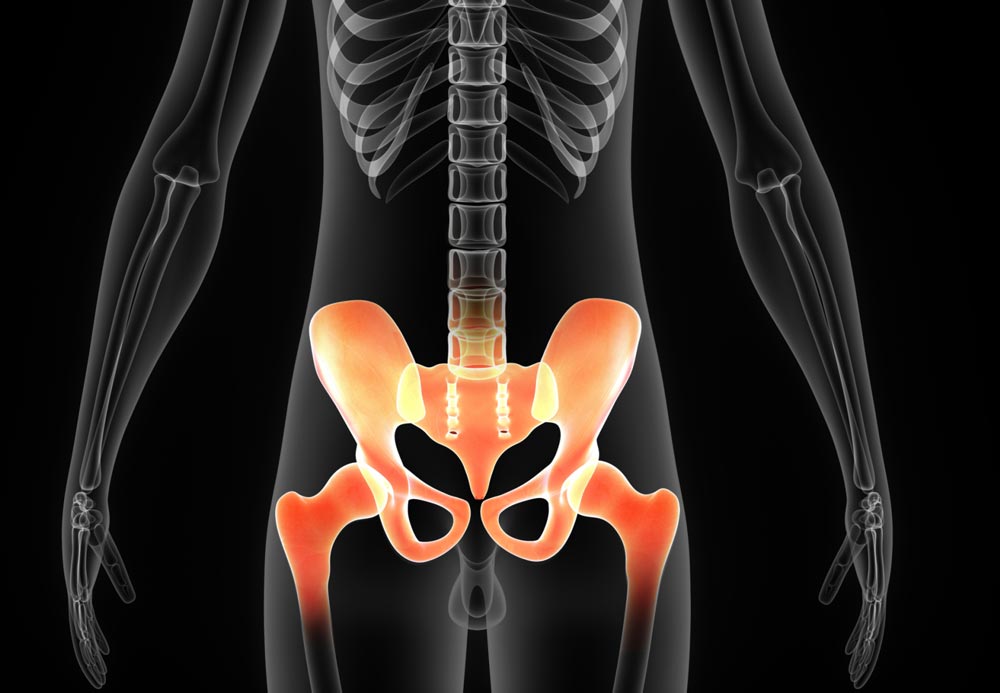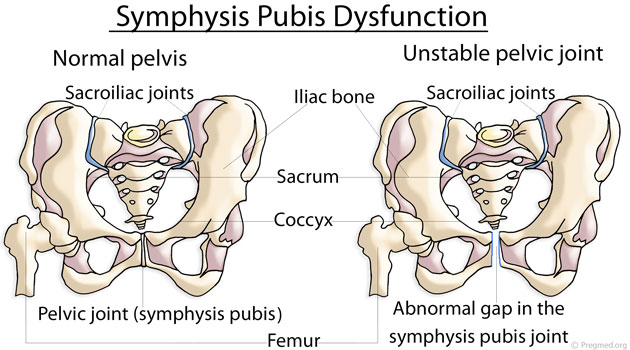 Simply put, it is when there is an abnormal gap at the region of the symphysis pubis of the pelvic joint. Normally, the two pelvic bones meet at the front, in a region called the pubis symphysis. When there is a gap of 1cm or more, either due to the effect of pregnancy hormones or trauma, the condition is described as symphysis pubis dysfunction. Other terms used to describe this condition are pubic diastasis or pelvic dislocation.
Simply put, it is when there is an abnormal gap at the region of the symphysis pubis of the pelvic joint. Normally, the two pelvic bones meet at the front, in a region called the pubis symphysis. When there is a gap of 1cm or more, either due to the effect of pregnancy hormones or trauma, the condition is described as symphysis pubis dysfunction. Other terms used to describe this condition are pubic diastasis or pelvic dislocation.
This post is going to focus more on the dysfunction which occurs in pregnancy. For trauma related condition, click here.
During pregnancy, production of the relaxin hormone which is responsible for loosening the ligaments and muscles in the hips, pelvis, pelvic floor and stomach to allow for the birth of the baby is increased. In some instances, the relaxin hormone can be released too early and so the pelvic region which is important in stability and weight transfer during normal activities becomes unstable and painful. It can also be related to an imbalance in the sacro-iliac joint.
Symptoms of Symphysis Pubic Dysfunction or pelvic dislocation
- Sharp pain or discomfort in the front region, around the pubic area
- Waddling gait…duck walking like a client reported.
- Pain when climbing stairs, lifting legs to get into the car,
- Pain worsens when laying on the back or turning in bed
- Clicking or grinding noise around the pubic region
- Shooting or sharp pain felt in the back, hip bones, upper thighs or back of the legs
There are a number of identified factors which makes some women more susceptible to symphysis pubic dysfunction or pelvic dislocation in pregnancy
- Excessive weight gain during pregnancy
- Multiple pregnancy or a big baby
- Strenuous exercises which the body is not used to
- Position of the baby is suspected to contribute
- Genes-the type of connective tissue a woman has may be contributory.
- Elevated basal metabolic rate may also be contributory.
Diagnosis of SPD
Usually, SPD can be diagnosed from the symptoms reported and the medical history and clinical examination. It is NOT advisable to expose a pregnant woman and the baby to x-rays and unnecessary scans.
Tips for managing symphysis pubic dysfunction
- Because the pelvis acts as a region where a lot of force passes through, it is helpful to stabilise it to minimise the discomfort that occurs there in SPD.
- Using pregnancy belts or bands or corset can help,
- Undergoing a weight transfer training on how to get out of bed, get into the car is helpful, the trick is to keep thighs together as much as possible when doing these movements. You sit with buttocks first then swing both legs together.
- Side sleeping using pillow support or cuddle you can help
- Avoid wearing heels if possible
- Use ergonomic chairs at work
- Don’t sit on the floor with legs crossed.
- Any exercise which stresses the region should be avoided. Upright bikes, jumping, squats and the likes should be avoided.
Treatment for symphysis pubic dysfunction or pelvic dislocation
Physiotherapists are rehabilitation professionals who manage SPD. PhysioCraft treatment protocol for SPD involves transfer training, pelvic floor exercises, and manual therapy for the muscles in the pelvis, hip and stomach region, soft tissue mobilisation, supportive garments and patient education. We also have hydrotherapy pools in our Ikoyi (Lagos) and Utako (Abuja) branches which benefit people greatly. Why not give us a call on +2348035670888, +2348171940921 or +2348179249555 if you have any inquiries or clarification.

